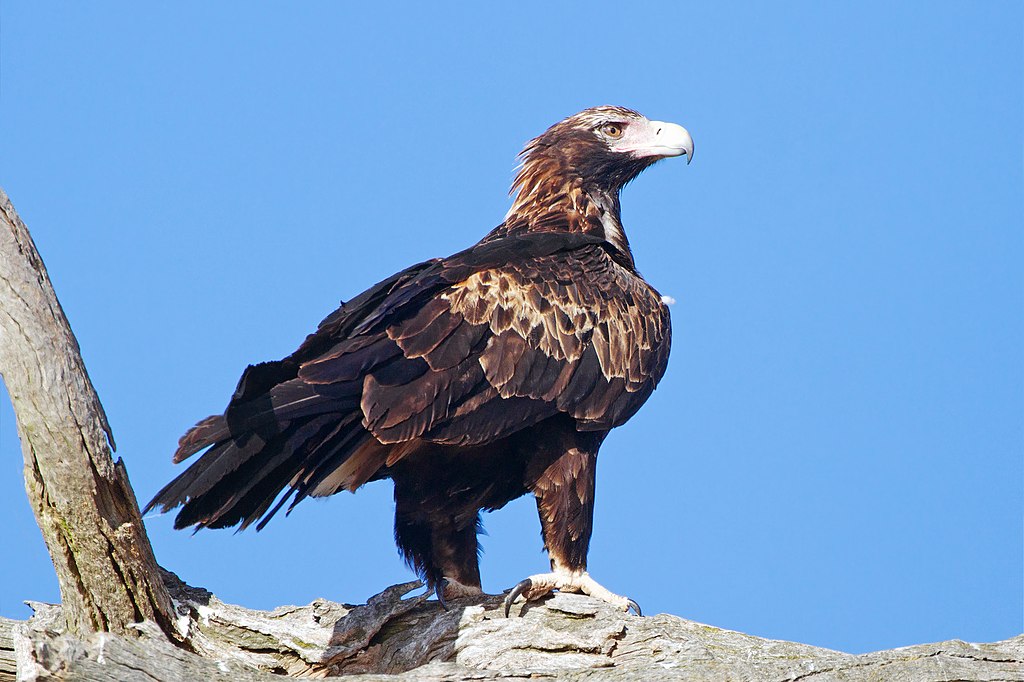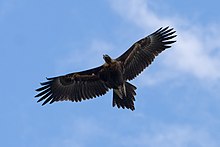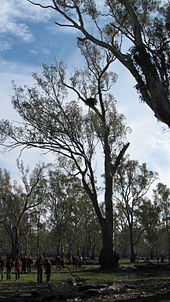The wedge-tailed eagle is one of 12 species of large, predominantly dark-coloured booted eagles in the genus Aquila found worldwide. A large brown bird of prey, it has a wingspan up to 2.84 m (9 ft 4 in) and a length up to 1.06 m (3 ft 6 in).[2]

Taxonomy
The species was first described by the English ornithologist John Latham in 1801 under the binomial name Vultur audax.[3]The two subspecies are:[4]
- A. a. audax (Latham, 1801) – Australia, southern New Guinea
- A. a. fleayi Condon & Amadon, 1954 – Tasmania
Description
In flight, the wedged tail is clearly visible.
Taking off from its perch, the long legs of this adult female are clearly visible.
Nest site in the Barmah-Millewa Forest
Nest in a leopardwood tree at Mutawintji National Park
At Symbio Wildlife Park, New South Wales, Australia
Wedge-tailed eagle
Young eagles are a mid-brown colour with slightly lighter and reddish-brown wings and head. As they grow older, their colour becomes darker, reaching a dark blackish-brown shade after about 10 years (birds in Tasmania are usually darker than those on the mainland). Adult females tend to be slightly paler than males. Although it rarely needs to be distinguished from other Aquila eagles, its long, wedge-shaped tail is unique to this species.
Its range and habitat sometimes overlap with the white-bellied sea eagle, which is similar in size and shape, and also has a somewhat wedge-shaped tail, although rather smaller and less distinctive. In silhouette and poor light, the two can look somewhat similar. Closer examination reveals the belly colour or tail size to distinguish the two.
Breeding and habitat
Aquila audax egg – MHNT
As the breeding season approaches, wedge-tailed eagle pairs perch close to each other and preen one another. They also perform dramatic aerobatic display flights together over their territory. Sometimes, the male dives down at breakneck speed towards his partner. As he pulls out of his dive and rises just above her; she either ignores him or turns over to fly upside down, stretching out her talons. The pair may then perform a loop-the-loop. The wedge-tailed eagle usually nests in the fork of a tree between one and 30 m above the ground, but if no suitable sites are available, it will nest on a cliff edge.
Before the female lays eggs, both birds either build the large stick nest or add new sticks and leaf lining to an old nest. Nests can be 2–5 m deep and 2–5 m wide. The female usually lays two eggs, which are incubated by both sexes. After about 45 days, the chicks hatch. At first, the male does all the hunting. When the chicks are about 30 days old, the female stops brooding them and joins her mate to hunt for food.
The young wedge-tailed eagles depend on their parents for food up to six months after hatching. They leave only when the next breeding season approaches.
Behaviour and diet
Wedge-tailed eagles are highly aerial, soaring for hours on end without wingbeat and seemingly without effort, regularly reaching 1,800 m (5,900 ft) and sometimes considerably higher. The purpose of soaring is unknown. Their keen eyesight extends into ultraviolet bands.
Feeding on carrion in the Pilbara region of Western Australia
They display considerable adaptability, and have been known to team up to hunt large red kangaroos, to cause goats to fall off steep hillsides and injure themselves, or to drive flocks of sheep or kangaroos to isolate a weaker animal.[9]
Carrion is a major diet item, also; wedge-tails can spot the activity of Australian ravens around a carcass from a great distance, and glide down to appropriate it. Wedge-tailed eagles are often seen by the roadside in rural Australia, feeding on animals that have been killed in collisions with vehicles.
This impressive bird of prey spends much of the day perching in trees or on rocks or similar exposed lookout sites such as cliffs from which it has a good view of its surroundings. Now and then, it takes off from its perch to fly low over its territory. During the intense heat of the middle part of the day, it often soars high in the air, circling up on the thermal currents that rise from the ground below. Each pair occupies a home range, which may extend from as little as 9 km2 (3.5 sq mi) to more than 100 km2 (39 sq mi). Within this home range lies a breeding territory around the nest. The eagle patrols the boundary of this home range and advertises its ownership with high-altitude soaring and gliding flights. It may defend its territory by diving on intruders. Adults are avian apex predators and have no natural predators, but must defend their eggs and nestlings against nest predators such as corvids, currawongs, or other wedge-tailed eagles, and in Tasmania, conflict with the white-bellied sea eagle often occurs over nest sites.
The wedge-tailed eagle is the only bird that has a reputation for attacking hang gliders and paragliders (presumably defending its territory). Cases are recorded of the birds damaging the fabric of these gliders with their talons. They have also been reported to attack and destroy unmanned aerial vehicles used for mining survey operations in Australia.[10]
The presence of a wedge-tailed eagle often causes panic among smaller birds, and as a result, aggressive species such as magpies, butcherbirds, masked lapwings, and noisy miners aggressively mob eagles (see video).
Conservation status
The subspecies from Tasmania (A. a. fleayi) is listed as endangered by the Environment Protection and Biodiversity Conservation Act 1999[11] with fewer than 200 pairs left in the wild. Like the thylacine, the eagle was once subject to a bounty in Tasmania, as it was believed to prey on livestock.Decreased numbers of Tasmanian devils (which are endangered) may be beneficial to the wedge-tailed eagles in Tasmania, as it could reduce competition for roadkill and devil predation on wedge-tailed eagle young, although that is not to say that devil populations should be reduced further.[12]
As an emblem
The bird is an emblem of the Northern Territory. The Parks and Wildlife Service of the Northern Territory uses the wedge-tailed eagle, superimposed over a map of the Northern Territory, as their emblem. The New South Wales Police Force emblem contains a wedge-tailed eagle in flight, as does the Northern Territory Correctional Services. La Trobe University in Melbourne also uses the wedge-tailed eagle in its corporate logo and coat of arms.[13] The wedge-tailed eagle is also a symbol of the Australian Defence Force, featuring prominently on the ADF Flag, and the Royal Australian Air Force and Australian Air Force Cadets both use a wedge-tailed eagle on their badges.[14] The Royal Australian Air Force has named its airborne early warning and control aircraft after the bird, the Boeing 737 AEW&C Wedgetail.Early in 1967, the Australian Army 2nd Cavalry Regiment received its new badge, a wedge-tailed eagle swooping, carrying a lance-bearing the motto "Courage" in its talons. The regiment's mascot is a wedge-tailed eagle named "Courage". Since its formation, there have been two, Courage I and Courage II. In 1997, while on flight training with his handlers, Corporal Courage II refused to cooperate and flew away, not being found for two days following an extensive search. He was charged with being AWOL and reduced to the rank of trooper. He was promoted back to corporal in 1998.[15][16]
The West Coast Eagles AFL football club from Western Australia uses a stylised wedge-tailed eagle as their club emblem. In recent years, they have had a real-life wedge-tailed eagle named "Auzzie" perform tricks before matches.[17]
- In flight, 'mobbed' by Australian magpie, Dayboro, SE Queensland
- Samsonvale, SE Queensland, Australia










No comments:
Post a Comment
Note: Only a member of this blog may post a comment.